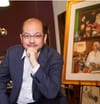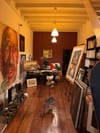From his father’s pioneering vision in education to his own journey as collector, curator, and cultural advocate, Lee Khai reflects on Penang’s artistic evolution and the value of plurality in the arts.
- Roots and inspiration: Lee attributes family influence for his early artistic spark
- Journey and mentorship: He recounts his life sojourn in arts — from being a collector to cultural leader
- Vision and philosophy: Lee believes in diversity, inclusivity, and the art ecosystem as important for Penang's artistic evolution
By Sebastian Lim
WHEN Penang lawyer and cultural advocate Lee Khai speaks about art, his words flow with both conviction and quiet humour. “My father always said that curiosity is a virtue,” he recalls. “Perhaps that’s why I’ve never been content to stay in one lane.”
His late father, Lee Chek Kong, was a visionary educator who championed statewide extracurricular programmes, including art education. Growing up in that creative and civic-minded environment shaped Lee’s sense of public service and his fascination with the arts. “Like him, I’ve always been a ‘busybody,’ curious about everything from law to literature,” Lee says. “He taught me the courage to pursue many interests at once.”
As a child, Lee’s connection to art was deeply personal — he loved drawing and even won third prize in a statewide art competition. But a self-awareness soon dawned: “I realised my hands were less talented than my eyes,” he laughs. “My strength was in appreciation, not creation.” That realisation redirected his passion from making art to collecting, curating, and advocating for it.

A leap of faith
Lee’s collecting journey began in 1995, during his first year in legal practice. At an exhibition of mainland Chinese art in Penang, he was drawn to a snow-scene painting by Yu Zhixue from Heilongjiang. “It cost twice my monthly salary,” Lee remembers, “but my artist friend James Sum said, ‘Buy lah! If you regret it, I’ll buy it from you’.” Encouraged, Lee took the leap — and never looked back. “That moment began a lifelong relationship with art,” he says.
His involvement deepened naturally. In 1996, he emceed Sum’s exhibition at the Penang State Art Gallery (PSAG). Later, he curated shows at the USM ABN AMRO Art & Cultural Centre, and managed Alpha Utara Gallery, founded by veteran artist Khoo Sui Hoe. These experiences, Lee says, “taught me how a gallery breathes.”
By 2006, Lee joined PSAG’s committee, becoming its chairman in 2017 and later advisor to the Penang Art District (PAD). These roles gave him a “360-degree view of the art ecosystem — from creation and curation to policy and preservation.” His legal training also became an asset, making him especially sensitive to issues of copyright, censorship, and tenancy that often affect artists. “The law and the arts are not as far apart as people think,” he observes. “Both are about making sense of human stories.”
For Lee, art has always been more than something to look at — it’s a way of connecting people and ideas. “It shapes how we see the world and how we understand one another,” he says.
Diversity as a guiding principle
Lee describes his art collection as rojak — “a little bit of everything.” It spans portraiture, landscape, conceptual art, and even digital works and NFTs. “I’m drawn to diversity rather than uniformity,” he says. “My Christian faith grounds me — I’m theologically conservative but culturally liberal.”

Rooted in Penang, his collection naturally centres on local and Malaysian art, but with an inclusive definition. “A Penang artist, to me, is anyone who has exhibited or developed their practice here,” he explains. “Art knows no passport. The dialogue between locals and foreigners enriches our culture.”

That same principle shapes PSAG’s policies: any artist who has held a solo show or participated in five group exhibitions in Penang qualifies as a “Penang artist.” This inclusivity underpins the Penang Annual Show, which Lee helped revive after decades of dormancy.
Mentors and moral anchors
Among his mentors, Khoo Sui Hoe stands foremost. “He’s known me since I was born,” Lee says. “His discipline, integrity, and devotion to painting have been a lifelong model.”
Equally formative was his father’s example as an educationist and social reformer. “He understood the power of narratives long before social media,” Lee says. “He taught me that ideas shape society — and that one must drive one’s own narrative, even when inconvenient."

Fragmentation or plurality?
Lee resists the idea that Penang’s art scene is fragmented. “Fragmentation implies disunity,” he argues. “I prefer ‘plurality’ or ‘multivocality.’ Art thrives on difference. What looks fragmented might actually be vibrantly diverse.” He likens Penang’s current scene to a dynamic ecosystem, alive with individual voices rather than a single dominant school. “Civilisation is defined by art, but art is defined by the individual soul.”
Penang’s visual arts, Lee observes, have moved through cycles of rise and quiet. Once the cradle of Malayan modernism, the island’s art scene dimmed in the 1980s as artists migrated to Kuala Lumpur and overseas. The revival came with George Town’s UNESCO World Heritage inscription and the explosion of street art. Ernest Zacharevic’s murals for the George Town Festival 2012 made Penang the only Asian city featured in Lonely Planet’s Street Art 1. “Street art doesn’t define fine art,” Lee says, “but it reignited public enthusiasm and drew young creatives here.”

Looking ahead, Lee believes Penang’s art scene will flourish when all players — artists, institutions, collectors, and policymakers — move in harmony. “It’s about creating an ecosystem where art isn’t just exhibited but lived,” he says. “Art connects people, opens conversations, and even heals. My hope is that Penang continues to nurture that connection.”
Lee remains committed to ensuring that Penang’s cultural ecosystem thrives through structure, inclusivity, and imagination. “Art gives a city its rhythm,” he reflects. “It teaches us empathy, perspective, and balance. Once we understand that, we’ll realise that culture is not something to decorate our lives — it is what gives our lives meaning.”
And Lee still cherishes the life-changing words from James Sum on his first art purchase: “Buy lah! If you regret it, I’ll buy it off you.” Those words of encouragement began a journey that has defined Lee's life for over 30 years.
Check out Part 2 of the interview with Lee Khai: Toward an integrated framework for Penang’s arts future. Click here





